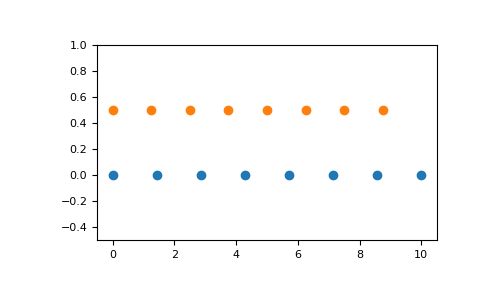numpy.linspace使用詳解
numpy.linspace(start, stop, num=50, endpoint=True, retstep=False, dtype=None)
在指定的間隔內返回均勻間隔的數字。
返回num均勻分布的樣本,在[start, stop]。
這個區間的端點可以任意的被排除在外。
| Parameters(參數): |
start : scalar(標量)
stop : scalar
num : int, optional(可選)
endpoint : bool, optional
retstep : bool, optional
dtype : dtype, optional
|
|---|---|
| Returns: |
samples : ndarray
step : float(只有當retstep設置為真的時候才會存在)
|
See also
- arange
- Similar to linspace, but uses a step size (instead of the number of samples).
- arange使用的是步長,而不是樣本的數量
- logspace
- Samples uniformly distributed in log space.
>>> np.linspace(1, 10, 10)
array([ 1., 2., 3., 4., 5., 6., 7., 8., 9., 10.])
>>> np.linspace(1, 10, 10, endpoint = False)
array([ 1. , 1.9, 2.8, 3.7, 4.6, 5.5, 6.4, 7.3, 8.2, 9.1]) In [4]: np.linspace(1, 10, 10, endpoint = False, retstep= True)
Out[4]: (array([ 1. , 1.9, 2.8, 3.7, 4.6, 5.5, 6.4, 7.3, 8.2, 9.1]), 0.9)
官網的例子
Examples
>>> np.linspace(2.0, 3.0, num=5)
array([ 2. , 2.25, 2.5 , 2.75, 3. ])
>>> np.linspace(2.0, 3.0, num=5, endpoint=False)
array([ 2. , 2.2, 2.4, 2.6, 2.8])
>>> np.linspace(2.0, 3.0, num=5, retstep=True)
(array([ 2. , 2.25, 2.5 , 2.75, 3. ]), 0.25)
Graphical illustration:
>>> import matplotlib.pyplot as plt
>>> N = 8
>>> y = np.zeros(N)
>>> x1 = np.linspace(0, 10, N, endpoint=True)
>>> x2 = np.linspace(0, 10, N, endpoint=False)
>>> plt.plot(x1, y, ‘o‘)
[<matplotlib.lines.Line2D object at 0x...>]
>>> plt.plot(x2, y + 0.5, ‘o‘)
[<matplotlib.lines.Line2D object at 0x...>]
>>> plt.ylim([-0.5, 1])
(-0.5, 1)
>>> plt.show()

numpy.linspace使用詳解
